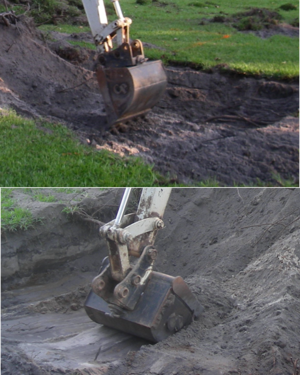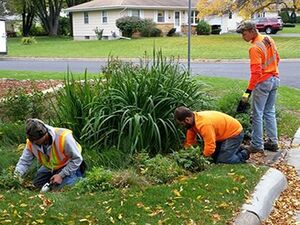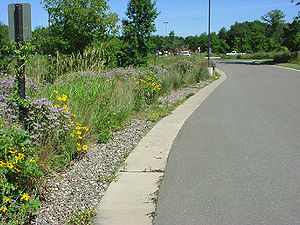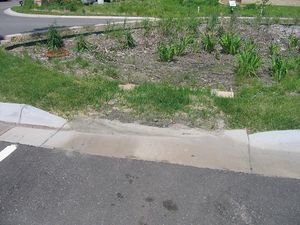
Operation and maintenance of bioretention and other stormwater infiltration practices
Contents
- 1
- 1.1 Overview of typical O&M issues
- 1.2 Design Phase O&M Considerations
- 1.3 Construction Phase O&M Considerations
- 1.4 Post-Construction Phase O&M
- 1.5 Maintenance Costs
- 1.6 Useful Resources
- 1.7 Case Studies
- 1.8 Maintenance Training Documents and Videos
- 1.9 O&M Resource Catalog
- 1.10 Example O&M Plans, Checklists, Reports, and Maintenance Agreements
- 1.11 References
- 1.12 Related pages
This page provides guidance for operation and maintenance (O&M) of bioretention and other stormwater infiltration practices, including above- and below-ground infiltration practices. This includes biofiltration, bioinfiltration, infiltration trenches, and infiltration basins.
Supplemental information can be found on the page called Operation and maintenance of bioretention and other stormwater infiltration practices - supplemental information. Supplemental information includes the following.
- Erosion protection and sediment monitoring, removal, and disposal
- Seeding, planting, and landscaping maintenance
- Snow storage
- Sustainable service life for infiltration and bioretention BMPs
- Maintenance agreements
- References
Overview of typical O&M issues
Bioretention practices and other stormwater infiltration practices (e.g. rain gardens, infiltration trenches) are vegetated landscape practices that capture, filter, and infiltrate stormwater runoff. In addition, these practices can provide ecosystem services such as nutrient cycling and storage, carbon sequestration, reduction in heat island effect, climate adaptation, and habitat for bees, butterflies, and other insects and small animals, including pollinators. Bioretention and other infiltration practices may be subject to high public visibility, greater trash loads, pedestrian traffic, vandalism, and vehicular loads, particularly in urban areas.
These practices require dedicated and regular maintenance to ensure proper and long-lasting operation and ecosystem benefits. Estimated bioretention lifespans range from 10 to 40 years (Drescher, 2012). The most frequently cited O&M concerns for infiltration practices include the following.
- Permanent standing water or flooding due to clogging caused by organic matter, fine silts, hydrocarbons, and algal matter. Clogging can occur at the surface, or in the inlet, outlet, or underdrain pipes.
- Runoff bypasses the practice due to incorrect grading and slopes, or because the inlet is blocked.
- Accumulation of trash and debris within the infiltration practice.
- Insufficient/inadequate vegetation or overcrowded vegetation .
- Inadequate pollutant removal due to improper soil media selection.
The sections below describe best practices to prevent or minimize these common problems.
Design Phase O&M Considerations
Designers should design bioretention and infiltration practices in ways that prevent or minimize O&M issues. Examples include the following.
- Limiting the contributing drainage area and sizing the practice in accordance to its contributing drainage area to prevent flooding issues.
- Providing pretreatment and trash racks to prevent clogging or trash accumulation.
- Providing a vegetation design plan, emphasizing
- native plantings (see Plants for Stormwater Design) to enhance pollinator and wildlife habitat, improve infiltration and evapotranspiration, reduce urban heat island effect, provide optimized carbon sequestration, and provide climate adaptation. Native plantings typically require less maintenance and replacement than non-native plantings because they are adapted to the local climate;
- site-specific plantings that take into account sun exposure, shade, proximity to traffic corners (visibility issues), interior vs exterior plantings, salt-tolerant plants, etc. The selection of plantings suitable to their immediate surroundings will minimize long-term care and replacement frequency.
- Specifying the optimized soil media composition and depth to effectively trap or sequester nutrients (phosphorus in particular), and that can also support the desired vegetation.
- Providing educational signage to increase public awareness.
- Installing measures like low fencing to prevent damage from pedestrian foot traffic .
Designers should consult and include any local requirements regarding green infrastructure. O&M considerations often depend on whether the practice is located on public land, private land, or in the public right of way. For example, plantings in the public right of way that conflict with any traffic safety considerations could require increased O&M, such as pruning or complete removal.
Designers should also recognize the need to perform frequent landscaping maintenance to remove trash, check for clogging, and maintain vigorous and healthy vegetation. Designers can incorporate design solutions to facilitate maintenance activities. Examples include
- incorporating multiple and easy site access points;
- installing observation wells; and
- providing recommendations of vegetation appropriate to the location.
The designer should also provide a site-specific O&M plan that includes
- construction inspection schedule and checklists,
- post-construction routine maintenance schedule and checklists, and
- operating instructions for the practice (if applicable)
Example O&M plans are provided below.
For more design information and criteria for individual infiltration practices, see the Design criteria for bioretention or Design criteria for infiltration practices pages.
Construction Phase O&M Considerations

Proper construction methods and sequencing play a significant role in reducing O&M problems. Some key items during the construction phase include the following.
- Before construction begins
- Ensure that the contributing drainage area is fully stabilized with vegetation prior to the beginning of construction. Also make sure that impervious areas in the contributing drainage area are clean. If this is not possible, use barriers or diversions to direct stormwater flows from the contributing drainage area away from the practice. See Sediment control practices for more information.
- Install any needed erosion protection and sediment controls in your construction site and prepare a storm water pollution prevention plan (SWPPP). See Erosion prevention practices and Sediment control practices for more information.
- Designate a stormwater supervisor to make sure someone is responsible for erosion and sediment control.
- Hold a pre-construction meeting with the designer and the installer to review the construction plans and the sequencing of construction.
- During construction
- Construct any pretreatment devices before constructing the main bioretention or infiltration system.
- Ensure heavy equipment does not enter the footprint of the practice to avoid compaction of the infiltration media.
- Store any soil or gravel media downstream of the practice footprint to avoid clogging the infiltration media. If this is not possible, store soil or gravel media in some type of covered or contained structure.
- Inspect the practice during construction to ensure that the infiltration practice is built in accordance with the approved design standards and specifications. This includes verification of the media composition and depths. Use detailed inspection checklists that include sign-offs by qualified individuals at critical stages of construction and to ensure the contractor’s interpretation of the plan is acceptable to the professional designer. Example construction phase inspection checklists are provided here.
- Ensure that the plant and vegetation mix conforms to the vegetation design plan, particularly if the vegetation was selected to provide ecological function (such as pollinator habitat).
- After construction
- Verify that the infiltration practice was built in accordance with the approved design and standards and specifications, including the pretreatment devices as well as the main infiltration practice.
- Verify that the contributing drainage area is fully stabilized with vegetation prior to removing any barriers, diversions, or erosion and sediment control measures.
- Verify that the practice actually captures and infiltrates runoff. Conduct a full inundation test to inspect the underdrain and outflow function. Conduct an infiltration test to verify post-construction infiltration rates. For more information, see Assessing the performance of infiltration or Assessing the performance of bioretention.
- Verify that the practice reduces nutrient loads. Collect inflow and outflow storm water samples and have them analyzed for nutrient concentrations.
- Use a detailed inspection checklist that includes sign-offs by qualified individuals at the completion of construction, to ensure that the contractor’s interpretation of the plan is acceptable to the professional designer. Example construction phase inspection checklists are provided here.
- Review and discuss the plant warranty/establishment period with the plant provider to understand the conditions under which failing plants will be replaced.
- Determine if stormwater should be kept offline from the practice until the seedlings are established.
- The design/construction team should provide the O&M team with the following information to be included in the O&M plan:
- The plant warranty .
- The “ as-built” plans of the practice
- A list of conditions that might cause failure of the practice if not properly maintained.
For information on construction specifications, see the links below.
Post-Construction Phase O&M

Effective short and long-term operation of bioretention and infiltration practices requires dedicated and routine maintenance. Proper maintenance will not only increase the expected lifespan of the facility but will improve ecological function, aesthetics, and property value. Important post-construction considerations are provided below.
- A site-specific Operations and Maintenance Plan should be prepared by the designer prior to putting the stormwater practice into operation. This plan should provide any operating procedures related to the practices. The plan should also provide clear maintenance expectations, activities, and schedules. Include photos if possible. Be clear about who is responsible for the maintenance and the type of expertise that will be needed for distinct O&M activities. The O&M plan should include an anticipated budget for O&M activities. The O&M plan should also include an example O&M inspection checklist and an example maintenance report. Example O&M plans and inspection checklists are provided here.
- A legally binding and enforceable maintenance agreement should be executed between the practice owner and the local review authority. Example maintenance agreements are provided here.
- Inspection and maintenance activities are distinct and can be done as separate activities or together. Inspection will typically assess the practice for any O&M issues, whereas maintenance will address the O&M issues identified by the inspection. A dedicated inspection effort on a large number of BMPs can help prioritize maintenance activities.
- Maintenance activities should not cause compaction or damage to vegetation. No vehicles or stockpiling should be allowed within the footprint of the practice. Foot traffic should be kept to a minimum.
- Maintenance activities should apply to all parts of the bioretention or infiltration practices, including the pretreatment devices, the main bioretention/infiltration area, the vegetation, the media, and any conveyance or discharge pipes.
- BMP areas generally should not be used as dedicated snow storage areas. Click here for additional snow and salt considerations.
Overview and schedule of general maintenance activities for bioretention and infiltration practices.
Link to this table
| First Year of Operation | ||||
|---|---|---|---|---|
| Activity | Frequency | Time period | Level of effort | O&M benefita |
| Check that there is no ponding in the pretreatment device and/or in the main treatment area. | At least twice after storm events > 0.5 inches | Within the first 6 months | < 1 hour | 1 |
| Check for evidence of clogging in the pretreatment device and/or in the main treatment area. | At least twice after storm events > 0.5 inches | Within the first 6 months | < 1 hour | 1 |
| Check for evidence of clogging or failing of the inlet, outlet, and bypass pipes. | At least twice after storm events > 0.5 inches | Within the first 6 months | < 1 hour | 1 |
| Remove any stormwater diversion or barriers once seedlings are established. | Once | When plants are sufficiently established | 1-2 hours | 1,2,3,4,5 |
| Supplemental watering during drier periods, particularly if keeping stormwater offline until plant seedlings are established. | 1/week initially | During first 2 months | 1-2 hours | 2,3,4,5,6 |
| As needed | First growing season | 1-2 hours | 2,3,4,5,6 | |
| Remove and replace dead plants | As needed | First growing season | 2-4 hours | 2,3,4,5,6 |
| Spot reseeding of bare patches and eroding areas | As needed | First growing season | 2-4 hours | 1,2,3,4,5,6 |
| After First Year of Operation | ||||
| Activity | Frequency | Time period | Level of effort | O&M benefita |
| Check that there is no ponding in the pretreatment device and/or in the main treatment area | Semi-annually | 48 hours after a rain event and when ground is not frozen. Note that deep sumps can have ponding | 1-2 | 1 |
| Check for evidence of clogging in the pretreatment device, the inlets/outlets/bypass pipes, and in the main treatment area. Look for evidence of short circuiting or low spots that cause flow path issues. | Semi-annually | n spring and fall | 1-2 | 1 |
| Supplemental watering | As needed during extended dry periods | During dry periods | 1-2 hours | 2,3,4,5,6 |
| Remove trash and debris from the pretreatment device and/or in the main treatment area. | Monthly during rainy season | All year long. Cleaning may need to be done more frequently during the summer storm season and less during the drier winter season | 1-2 hours | 1,5 |
| Inspect for and remove excess sediment in the pretreatment device and/or in the main treatment area. | Monthly | All year long | 4 hours if removal is needed | 1 |
| Check and repair eroded areas | Annually | In fall or spring when vegetation has died down | 4 hours if repair is needed | 1,2,3,4,5 |
| Mow grass filter strips and bioretention turf cover | Seasonally, but outside of the main pollinator or wildlife nesting season | During growing season | 1-2 hours | 2,3,4,5 |
| Weed and remove invasive plants | Twice during growing season | During growing season | 1-2 hours | 2,3,4,5 |
| Inspect plant composition and health and replace as needed | Annually | In fall or spring | 4 hours if plant replacement is needed | 2,3,4,5,6 |
| Prune trees and shrubs | Annually | In fall or spring | 2-4 hours | 2,3,4,5 |
| Inspect for and repair broken inlets or pipes | As needed | Any time | 2 hours, more if repairs are needed | 1 |
| Renew mulchb | As needed | In fall or spring | 1-2 hours | 4,5 |
| Spring cleanup (cut back and remove last year’s material) | Annually | In spring | 2-4 hours | 2,3,4,5 |
| Fall cleanup (removed excessive leaf litter, particularly in areas with lots of trees) | Annually | In fall | 2-4 hours | 2,3,4,5 |
| After 5+ Years of Operation (non-routine maintenance) | ||||
| Activity | Frequency | Time period | Level of effort | O&M benefita |
| After long term operation of the practice, some occasional and infrequent maintenance activities might be required, such as bigger repairs, soil regeneration, or redesign of key elements of the practice. | As neede | As needed | Could be significant depending on the activity | 1,2,3,4,5,6 |
|
aKey to Maintenance Benefits:
|
||||
Common problems and how to troubleshoot them for bioretention and infiltration practices
Link to this table
| Symptom | Possible causes | Solution |
|---|---|---|
| Standing water within the infiltration area for more than 48 hours | The surface of the ponding area may become clogged with fine sediment over time. This might be because the pretreatment is no longer working, or there are excessive sediment loads due to erosion or high sediment loads from the contributing area. |
|
| Rainwater does not appear to flow to the infiltration area | Leaves, sediment, trash, or plant debris may be blocking the flow path. | Remove these materials on a regular basis |
| Vegetation is not able to establish | Plant selection is inappropriate for the site | Consult with a landscaper or horticulturist. Check that plants are suited to the local conditions. Make sure BMP is protected from snow storage or salt application. |
| Erosion or scouring around the inlet | Flow is obstructed by debris or improper grading | Correct for drainage and flow path issues to make sure flows are evenly distributed. Make sure the flow paths are unobstructed. |
Maintenance Costs
Maintenance costs will vary on a number of factors, including but not limited to:
- Size of the practice and its contributing drainage area
- Type of plantings used
- Site visit frequency
- Level of maintenance needed
- Local weather conditions
- Staffing needs (number of staff, external vs. internal staff, etc)
- Travel time between sites
- Efficiencies of scale (single GI vs. a cluster of GI)
- Equipment needed
Preventative maintenance is key to minimizing major costs associated with repairs. A general rule of thumb to estimate maintenance costs is 3%-6% of the installation costs, but can run higher. Maintenance may be higher the first few years, while plants are being established. Maintenance costs should account for the number of hours of labor, the cost for different types of labor expertise required, and any equipment needed to successfully complete the maintenance activities.
A study published in 2017 by ASCE shows the median annual maintenance cost of bioretention devices was estimated at $0.687/sq ft with lower and higher costs of $0.13/sq ft and $2.30/sq ft, respectively. The survey also provides average annual reported maintenance costs, which range from $250 to $3880 with a median of $850 (Clary, 2017).
Useful Resources
More detailed information regarding specific maintenance activities are provided here. Topics discussed include:
- Erosion protection and sediment monitoring, removal, and disposal – protecting your investment
- Seeding, planting, and landscaping maintenance – keeping it looking good
- Snow Storage
- Sustainable service life for infiltration and bioretention BMPs
- Maintenance agreements
- Additional References
Case Studies
- None identified that specifically include maintenance considerations.
Maintenance Training Documents and Videos
- Chesapeake Stormwater Network TECHNICAL BULLETIN No. 10. Bioretention Illustrated: A Visual Guide for Constructing, Inspecting, Maintaining and Verifying the Bioretention Practice
- Archived webcast from Chesapeake Stormwater Network - TRUST BUT VERIFY: Urban BMP Verification in the Chesapeake Bay
- Archived webcast from Chesapeake Stormwater Network - Bioretention Maintenance: In the Trenches
- MSD Rain Garden and Planter Box Maintenance video
- DOEE RiverSmart Rain Garden Maintenance video
O&M Resource Catalog
MPCA has compiled publicly available O&M resources related to green infrastructure. This non-exhaustive catalog is intended as a resource to practitioners.
Example O&M Plans, Checklists, Reports, and Maintenance Agreements
- Operation & Maintenance Plan
- Construction phase inspection checklist
- O&M inspection checklist
- O&M example report
- Maintenance Agreements
References
- Drescher, S.R., Karen Cappiella, Greg Hoffman, and Bryan Siepp. 2012. Trees in Bioretention. Center for Watershed Protection, Inc., Ellicott City, MD.
- Clary, J., Piza, H. 2017. Cost of Maintaining Green Infrastructure. American Society of Civil Engineers (ASCE), Reston, VA.
Related pages
- Operation and maintenance of bioretention and other stormwater infiltration practices
- Operation and maintenance of green roofs
- Operation and maintenance of vegetated strips
- Operation and maintenance of permeable pavement
- Operation and maintenance of tree trenches and tree boxes
- Operation and maintenance of vegetated swales
- Operation and maintenance of stormwater treatment wetlands
- Operation and maintenance of rainwater harvesting
Supplemental guidance
- Supplemental guidance - operation and maintenance of bioretention and other stormwater infiltration practices
- Supplemental guidance - operation and maintenance of green roofs
- Supplemental guidance - operation and maintenance of vegetated strips
- Supplemental guidance - operation and maintenance of permeable pavement
- Supplemental guidance - operation and maintenance of tree trenches and tree boxes
- Supplemental guidance - operation and maintenance of vegetated swales
- Supplemental guidance - operation and maintenance of stormwater treatment wetlands
- Supplemental guidance - operation and maintenance of rainwater harvesting


